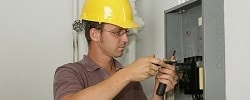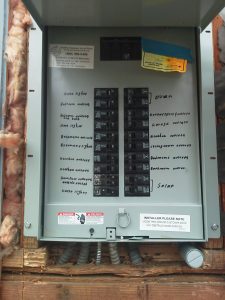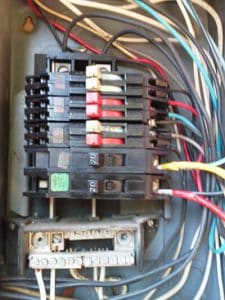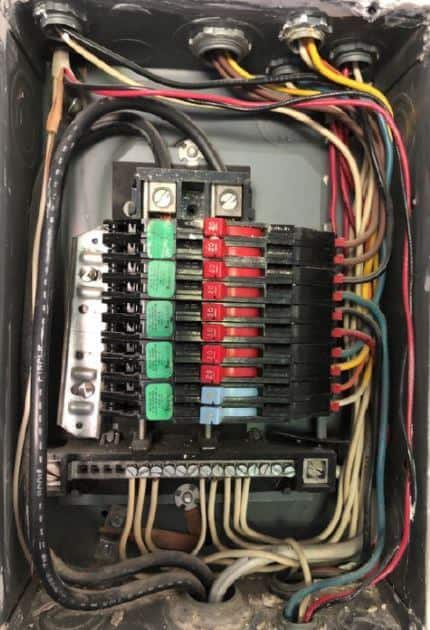As a homeowner or business owner, it’s important to have a basic understanding of your electrical panel and circuit breakers. This knowledge can help you identify potential problems and ensure that your electrical system is functioning properly.
In this article, we will discuss the basics of electrical panels and circuit breakers, and provide tips on how to maintain and troubleshoot these essential components of your electrical system.

Take a Look at Your Electrical Panel
The electrical panel, also known as the service panel, is the central hub of your home or business’s electrical system. It receives power from the utility company and distributes it throughout your building via a series of circuits.
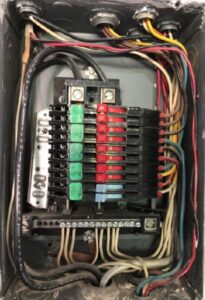
The panel is typically located in a utility room or basement and is composed of a metal box with a door that houses a series of circuit breakers or fuses. The size and capacity of the panel will depend on the size of your home or business and the electrical load it needs to support.
What are Circuit Breakers
Circuit breakers are safety devices that are designed to protect your electrical system from overload, short circuits, and electrical faults. They are installed in the electrical panel and can be reset manually when they are tripped.
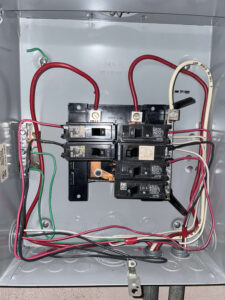
When a circuit is overloaded, the circuit breaker will automatically switch off to prevent damage to your electrical system or the risk of an electrical fire. Fuses work similarly but are replaced when they “blow” and need to be replaced.
One important thing to note is that if you have an older home or building, it may still be equipped with a fuse box rather than a circuit breaker panel.
Fuse boxes work similarly to circuit breakers, but instead of being reset manually, they need to be replaced when they blow. If you have a fuse box, it’s important to have it inspected by a licensed electrician to ensure that it’s functioning properly and up to code.
What’s Next
It’s important to keep your electrical panel and circuit breakers in good condition to ensure that your electrical system is functioning properly and safely.
Here are some tips on how to maintain and troubleshoot your electrical panel and circuit breakers:
- Keep the area around the panel clear: It’s important to keep the area around the electrical panel clear of clutter and debris to ensure that it’s easily accessible in case of an emergency.
- Schedule regular inspections: It’s recommended to have your electrical panel and circuit breakers inspected by a licensed electrician every 3-5 years to ensure that they are functioning properly and up to code.
- Check for signs of wear and tear: Look for signs of wear and tear on the electrical panel, such as rust or corrosion, loose wires or connections, or burn marks. If you notice any of these signs, contact a licensed electrician immediately.
- Test your circuit breakers: Test your circuit breakers periodically by flipping them on and off. If a breaker is difficult to reset or doesn’t reset at all, contact a licensed electrician.
- Upgrade to a new panel: If you have an older electrical panel that is no longer functioning properly or is not up to code, consider upgrading to a new panel. This can improve the safety and efficiency of your electrical system.
In conclusion, understanding your electrical panel and circuit breakers is an essential part of maintaining the safety and efficiency of your electrical system.
If you’re experiencing any issues with your electrical panel or circuit breakers, it’s important to contact a licensed electrician to diagnose and repair the issue.
The Electric Connection is a reliable and trustworthy electrical contractor that can help with any electrical issues you may have in the Los Angeles area.
Why do breakers trip? Have you ever turned on the vacuum or started the microwave while the toaster was in operation and experienced a tripped breaker? If you have ever dealt with a breaker that trips, you are probably wondering why it happened and want to know what that means for the safety of your home. An electrician in Pasadena is here to explain. You can learn more by calling The Electric Connection.
First of all, it is important to explain what a tripped breaker really is. Your breaker panel is probably located outside or in a hallway or basement area. When a breaker trips, it cuts off all flow of electricity to the outlets and light fixtures that the particular breaker supplies electricity to. When looking at the breaker panel, the tripped breaker will be slightly in the middle instead of all the way left or right. An orange bar is usually used to indicate which breaker has tripped.
As far as why the breaker trips, there are 3 main reasons
• Ground Fault
• Overloaded Circuit
• Short Circuit
An overloaded circuit is probably one of the most common reasons. If your breaker isn’t powerful enough to run several appliances at once, like the microwave, vacuum and toaster, it becomes overloaded and shuts down. You can address this by distributing your electrical draw to different outlets that are run by different breakers or by having your Pasadena electrical system investigated. You may be in need of additional breakers.
A ground fault or short circuit are much more dangerous than an overloaded circuit. Breakers that have bare wires or a bad connection can cause fires. If you don’t see anything out of the ordinary, but are still having trouble with a tripping breaker, give the folks at The Electric Connection a call.
Have you decided to take the plunge—pun intended, and buy a hot tub? Coming home after a long day and climbing into a hot tub can be extremely satisfying. The hot water bubbling and washing over sore muscles can soothe all those aches and pains that tend to build up over the day.
Your first step is to head to the specialty store that sells the hot tubs. Pick the tub that is the right size for your family’s needs. There are a lot of choices and this may be a process that takes you several weeks. Once you have chosen the perfect tub, you need to decide exactly where it is it will go in your yard. Remember to consider the power needed to operate the tub when you are thinking of placement. Then, you will need to call your electrician. Beverly Hills homeowners can give The Electric Connection a call to discuss installation.
Because of the amount of electricity needed to power a hot tub, it requires a dedicated breaker. The luxury appliance will also need to be hard-wired into your home’s main power. This is a big job that requires the experience and knowledge of a certified electrician. In most cases, county and city codes require a licensed electrician completes the hook up.
If your home is older, you may need to have an electric panel upgrade to accommodate the new hot tub. If you are unsure of what you have, call your electrician. Beverly Hills homeowners will need to ensure their home has the additional power needed to power the hot tub. This is typically not something the average person would be able to tell by simply looking at the electric panel.
Give The Electric Connection a call and we will be happy to inspect your electrical panel and complete the hot tub installation for you.
If you have a breaker or several breakers that are tripping, there are some things you can do to keep it from happening. If you are not comfortable with trying to diagnose the problem, you can call The Electric Connection. We have skilled electricians who can certainly take care of the troubleshooting process for you.
Follow these troubleshooting guidelines from your electrician in Glendale to see if you can identify the problem.
1-Note what is plugged in when the breaker trips. It is possible the breaker is being overloaded. You will need to reduce the number of appliances running off of one breaker. Microwaves should be on their own outlet when possible. Do not resort to using several powerstrips that are completely loaded. This is another major draw and can overburden a breaker. If you need additional outlets or another breaker, give your electrician a call.
2-Your large appliances like the air conditioning unit, hot tub or dryer should all be on their own dedicated circuits. If this is not the case, call an electrician. Glendale homeowners will need the expertise of a certified electrician to take care of this situation.
3-Carefully check each appliance that is plugged in when the breaker trips. There may be an issue with the appliance or the wiring. Don’t use it anymore.
A breaker that trips often for no apparent reason should always be inspected by an electrician. It could be an indication of a bigger problem. Sometimes, the breaker will need to be replaced. In other cases, the electrical wiring to the outlet/s may be the issue. In any event, it is always a good idea to have an electrical inspection completed to check for any serious problems that could be a fire hazard. If you are interested in learning more about this, give The Electric Connection a call today.
Under normal circumstances, a circuit breaker lasts for years without ever needing repair or replacement. However, from time to time a circuit breaker will actually “break.” Diagnosing a circuit breaker problem is not a project that an amateur should attempt on his or her own. Only the most skilled do-it-yourselfers can handle this project. Unless you are skilled in electrical safety practices and the proper use of electrical test equipment, contacting an electrician in Los Angeles just makes sense.
If you have a breaker that is tripping regularly, more than likely the breaker is doing its job—the circuit is just overloaded. A skilled electrician Los Angeles can test this by using an ammeter—a tool that is used for testing the amount of electricity going through the circuit. Another problem that occurs regularly is that the breaker will not reset after tripping. In this case, the problem is more likely in the line of electricity rather than the breaker. In most cases the line has a fault and the breaker will (purposely) not reset until the fault is cleared.
When an electrician comes to test your breaker, he will likely first test the voltage at the breaker terminal. Generally, the reading should show 120 VAC. If this appears correctly, he will load the circuit and test again. If voltage drops at this point, there is a good chance the breaker is bad.
Since this is a job that is so in-depth and difficult, calling an electrician from The Electric Connection is highly recommended. These experts have years of experience and training, so they are able to review your problem and determine the best way to proceed. There is no use in taking risks when it comes to your safety and the safety of your home; an experienced electrician is just a phone call away.
